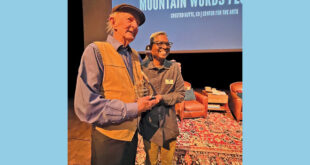By Polly Oberosler
Remembering Us
Reading the Sunday New York Times, I caught an article written by Lily Koppel regarding the 50-year anniversary of the Apollo 1 tragic fire that, in a routine launch test at Cape Canaveral on January 27, 1967 took the lives of three NASA astronauts. Her article attracted my attention partly because I am interested in space, but also because Gus Grissom, one of three who were killed, had a house in what is now Mt. Crested Butte.
I remember Grissom being a matter of local pride, for he was revered as a national hero as all those boys were, but came among all of us with unassuming expectations. His time here was short, dying at 40 years of age, but he involved all of us in the Apollo program and the missions simply because of the connection he had here.
Locally he represented the beginnings of the shift from coal power of the past to the nuances of the future where electronics, chemistry, atomic and thoughtful engineering were in the bloodstream of pure horsepower.
He and his colleagues helped remind Americans that we could do anything we set our minds to. The Apollo program grabbed the attention of a nation with hope, dreams, pride and wonder. The United States was taking the ambitions of a president long gone who had challenged America to be the best we could be, and breaking the sound barrier along the way.
I had a very cool sixth-grade teacher who understood the exceptionalism of America and the space program, and he challenged us to study the missions and make an Apollo spacecraft out of cardboard, covered with foil to replicate an Apollo space capsule with the American flag on the side. The craft was built nearly to scale and had a small window, hatch and seats for three astronauts in the characteristic reclined position. Our daily lesson included replicating in the classroom what the mission did on each day. We pored over newspaper articles about the mission and were excited as the day of the launch approached.
Three “astronauts” were elected to serve and we supplied them with “Space Sticks,” which were complete diet nutrition bars replicating what the real crew would have to eat. The class made helmets and spacesuits for the astronauts that included motorcycle helmets covered with foil, hoses and wires necessary to supply them with oxygen and spacesuits made of foil. The day was near!
The day of the launch we were all puffed up with pride, not just for our little play launch, but alongside the nation, we were exceptional. The USA was the envy of the world and we were looked up to like no other time because we were moving forward in giant leaps for mankind much as the mission would move around earth. We watched the launch prep, I think, on TV and loaded our men with “The Right Stuff” into their cabin, buckled them in, closed the hatch and bid them good flight. In the back of the room we had “Mission Control,” where all of us technicians took our positions behind cardboard monitors. The world’s eyes were on the heavens and the United States, as they always are.
That mission was a success in real time and for all of us. We learned how unique, but humble, America is and the satisfaction we felt at being a team. That sixth-grade class came from all walks of life: one astronaut was the son of a state patrolman; another my rock-hound buddy whose dad worked at the fish hatchery; and the third was a rancher’s son. All were exceptional, not necessarily at being the best students or the finest athletes or even the best looking, but for honesty and integrity. They were who America has always been, a mix of people, each with unique contributions to make to the overall mission. There were girls on the technical team, Latino kids on mission control and our teacher was crippled with polio; the mission was well equipped.
The tragic fire of Gus Grissom’s mission was in the rear-view mirror. The NASA program had learned from mistakes and we were moving on. We never considered going back because forward is a necessary direction if you want to see things clearly. There wasn’t much we were afraid of because Americans met the world head-on, but did it with dignity and poise just like our astronauts. We have always been respected and admired, as we are now, for our forward thinking, can-do approach to life and our unwavering commitment to equality and opportunity for all.
In remembrance of her husband, Ms. Grissom, now 89 years old, was the one who pushed an annual memorial for the fallen heroes of NASA lest they be forgotten for their daring contributions to American grit. Her words in the interview were poignant as she was quoted saying matter of factly, “Never give up.” Turning to her son later, she observed, “The stars are out tonight.” She is always looking forward and is exceptional for being part of the journey of the American experience.
Our country is as special as our heroes, for it created them, and we must remember why we got here and what the mission is. We cannot forget our greatest asset, and that is us, all of us, for the sake of the mission.
 The Crested Butte News Serving the Gunnison Valley since 1999
The Crested Butte News Serving the Gunnison Valley since 1999




